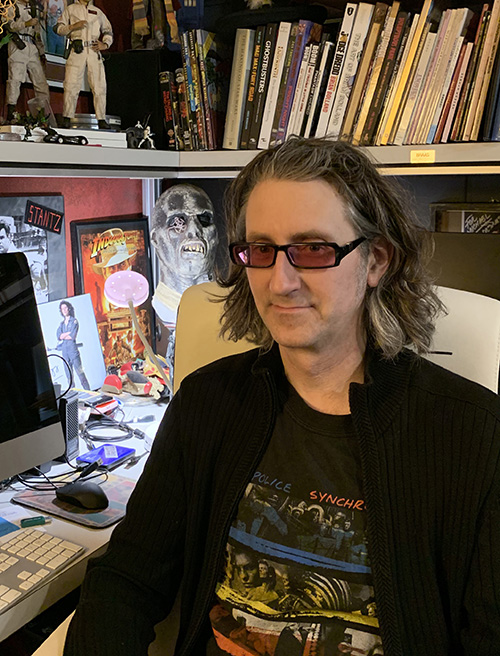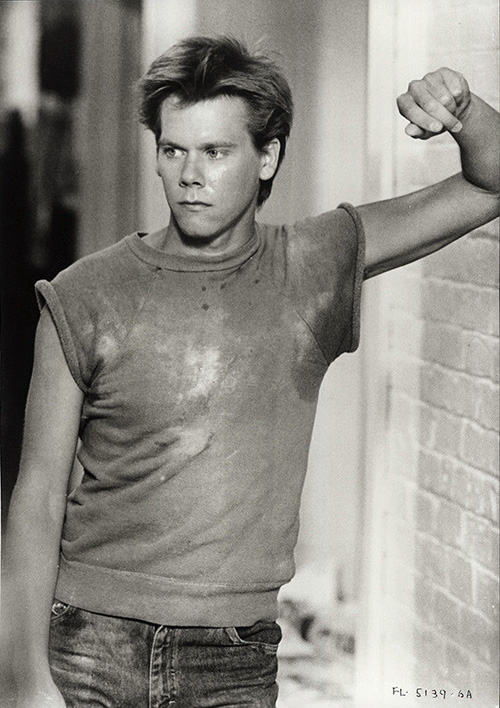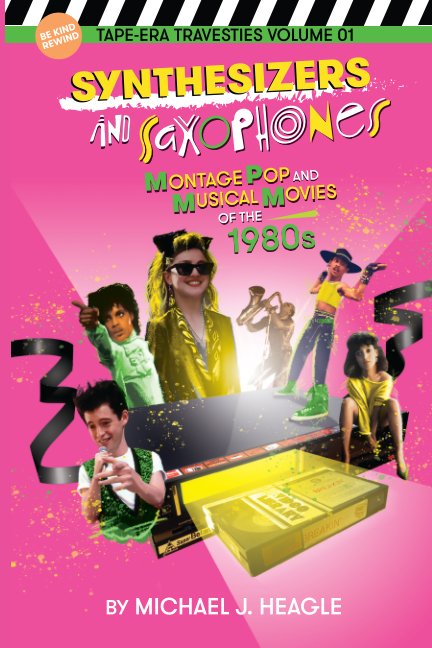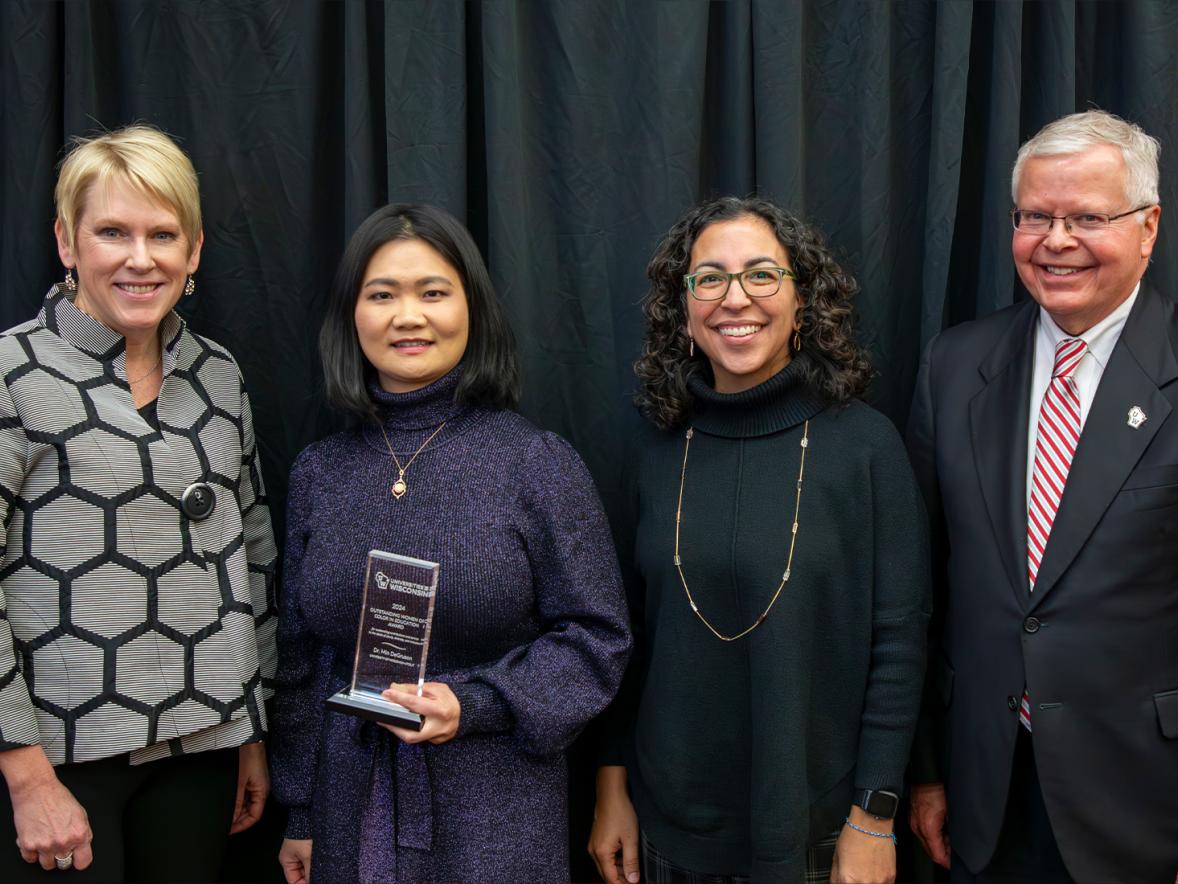From “Flashdance” and “Footloose” to “Valley Girl” and “Vibes,” Michael Heagle, like totally, believes the 1980s were “tubular.”
The University of Wisconsin-Stout Assistant Professor of time-based media has published the book “Synthesizers and Saxophones: Montage Pop and Musical Movies of the 1980s.” It is volume one of a series he plans entitled “Tape-Era Travesties.”
 In the reference-type book, Heagle looks at the story behind great movie titles, hit soundtrack albums and musical movies of the 1980s. It includes information on movie musicals like “Purple Rain” and “Streets of Fire,” to cult movies with a musical bent including “The Last Dragon” and “Howard the Duck.” The book includes animated films, heavy metal horror movies and others. About 70 films are part of the book.
In the reference-type book, Heagle looks at the story behind great movie titles, hit soundtrack albums and musical movies of the 1980s. It includes information on movie musicals like “Purple Rain” and “Streets of Fire,” to cult movies with a musical bent including “The Last Dragon” and “Howard the Duck.” The book includes animated films, heavy metal horror movies and others. About 70 films are part of the book.
“It’s a critical work and an informative work,” Heagle said. “For a while, it seemed like the pop music and movies were inseparable. Radio sounded like MTV, MTV influenced TV and the movies, and the pop charts looked like the movie listings and vice versa.”
Heagle started working on the book in February 2018. He had just accepted employment at UW-Stout and decided to fill the gap before he started teaching in the fall by writing a book. “Synthesizers and Saxophones” ended up taking him about a year to write. “My life is equally balanced between a music and movie obsession,” Heagle said.
In the book, he notes that several conditions contributed to the music-film convergence of the 1980s.
Studios saw the money that could be made from an album tie-in. Releasing a potential hit song from a movie soundtrack before the movie came out could help fuel the film’s success, and the film could influence the song’s success. Albums and singles afforded cross-promotional opportunities, Heagle noted.
Having a chart-topping song with the movie’s title helped promote a picture for a fraction of the cost. Teenagers in the 1980s were affluent and had money to spend on what they wanted, including fashion. The rise of cable television and the VCR contributed to the success of films in the 1980s, providing alternative streams of revenue as audiences took the cinema to their homes, as well as the rise of the Walkman as a personal stereo, Heagle said.
The book also looks at the influence of MTV and asks the “gnarly” question: Did MTV ruin the movies? “When I was growing up this was the MTV era,” Heagle noted.
On MTV, movie music was played with scenes taken from the movies to make videos, promoting the film and the music, to the target audience of ages 12 to 25. “If you had a hot soundtrack and could get your free three-minute advertisement for it running endlessly on MTV, your movie was in for a serious uptick in business,” Heagle wrote.
The movie “Footloose” starring Kevin Bacon is a “bodacious” example of that. The movie tells the story of Ren McCormack’s shock when he moves from Chicago to a small, conservative Midwestern town that banned rock music and dancing and how he and his friends strive to change attitudes. Most songs from the film got radio play, and four of them were in heavy rotation with music video tie-ins on MTV. “That was a very popular way to cross-market,” Heagle said.
When asked about the absolute “schweet” movies, along with “Footloose,” that epitomized the crossover, Heagle cites “Flashdance,” a 1983 film starring Jennifer Beals, a young woman who works in a steel mill and dances in a bar at night as she strives to get into a prestigious dance conservatory; and “Top Gun,” the 1986 film about fighter pilot Maverick, performed by Tom Cruise, sent to the Top Gun Naval Fighter Weapons School, where he is at odds with other pilots. The Top Gun soundtrack has sold almost 12 million copies worldwide, making it one of the most successful soundtracks of all time.
In the 1990s, subgenres of music evolved, including indie rock, grunge and hip hop, splintering music fans and ending MTV as it was known in the 1980s.
The total “gag-me” movie and music crossover that proved the trend had worn out its welcome, in Heagle’s opinion, is the 1991 movie “Teenage Mutant Ninja Turtles II: The Secret of the Ooze.” The film features an extended cameo and showstopping musical number by rapper Vanilla Ice. “It’s enjoyably horrible,” Heagle said.
Heagle’s “absolutely radical” 1980s movie is “Purple Rain” starring Prince. The 1984 film was the acting debut of Prince, who played “The Kid,” a quasibiographical character. The film showcased Prince’s talents with several concert sequences. “It’s big, it’s sparkly, it’s smoky and it’s purple,” Heagle wrote in the book. “Regardless of what critics might say, ‘Purple Rain’ is the most luscious looking musical movie of this period, and its songs are among the most successful and timeless of the entire decade. But it’s the one-two punch of the album and the film itself that launched Prince into mainstream success. It’s hard to believe that prior to that movie he only had one crossover album, ‘1999,’ and had never cracked the top five on the pop charts.”
Erik Evensen, associate professor of design, used Heagle’s book right away earlier this semester when he was talking to colleagues about “Transformers: The Movie,” a 1986 animated feature. “My favorite bit of trivia about that film is that the great Orson Welles appears in the final role of his life, as a giant robot so prodigiously large it eats entire planets,” Evensen said. “Nobody ever believes that, but it's totally true. When I got home from campus, my copy of ‘Synthesizers and Saxophones’ had just arrived in the mail, and when I opened the book, it only took a few seconds to stumble upon the ‘Transformers’ entry, which included the bit about Welles. The book is a must-have reference for any fans of ’80s pop culture.”
Heagle’s knowledge on 1980s music and movies is “top drawer,” Evensen said. “Michael's book is an incredibly deep dive into ’80s movies, especially those defined in large part by their soundtracks,” Evensen added. “I've been a fan of movies like this since my childhood, trolling the aisles of my local VHS rental shop, so it's been great reading through the chapters and making mental notes to rewatch so many things. There are plenty of movies I haven't seen and several that I'd never heard of. He does cover the expected staples, such as “Flash Gordon,” “Flashdance” and the filmography of John Hughes, but he also chronicles plenty of lesser-known gems, like “Rockula,” a 1990 musical rom-com about a vampire who uses his vampire powers to become a rock star and woo his girlfriend, co-starring Toni Basil and Thomas Dolby.”
Heagle, who has made movies since he was in fifth grade and is the co-creator for the puppet comedy series “Transylvania Television,” grew up in Mukwonago in the 1980s. He had been a screenwriter, director, production designer editor and visual effects supervisor in self-funded, independent projects. He knows how difficult it is to make a film and has great respect for all filmmakers. “Every film has merit,” he noted. “I hope with this book people gain a new-found respect for a movie they dissed as a kid.”
 The book is available from Amazon for $12.99 and on Blurb for $12.90. This is Heagle’s first full-length book.
The book is available from Amazon for $12.99 and on Blurb for $12.90. This is Heagle’s first full-length book.
Other books Heagle is planning in the Tape-Era Travesties series are “1988 Fright time Annual,” looks at 1988, a banner year for the horror movie boom including sequels and remakes; “Ninjas and Nunchucks,” looks at select 1980s martial arts movies; and “Warriors and Wastelands,” that ranks and reviews the apocalyptic visions of 1980s filmmakers.
###
Photos
Michael Heagle says for a while in the 1980s it seemed as if music and movies were inseparable and movie and music tie-ins meant profits for studios.
Kevin Bacon in a publicity still from the movie “Footloose.”
“Synthesizers and Saxophones: Montage Pop and Musical Movies of the 1980s” is Heagle’s first full-length book and is the first in the Tape-Era Travesties series he is planning.
“Valley Girl” movie poster






